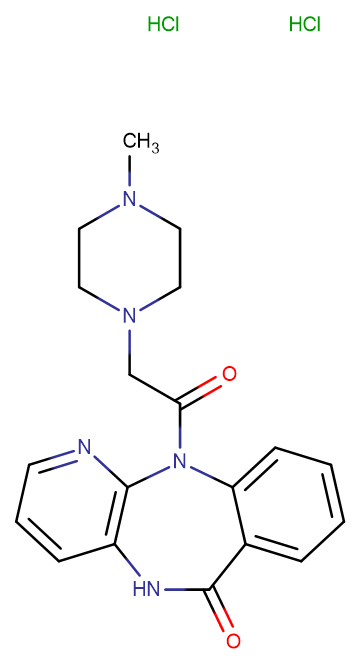
Pirenzepine dihydrochloride
CAS No. 29868-97-1
Pirenzepine dihydrochloride ( —— )
Catalog No. M13915 CAS No. 29868-97-1
An antimuscarinic agent that inhibits gastric secretion at lower doses than are required to affect gastrointestinal motility, salivary, central nervous system, cardiovascular, ocular, and urinary function.
Purity : >98%(HPLC)
 COA
COA
 Datasheet
Datasheet
 HNMR
HNMR
 HPLC
HPLC
 MSDS
MSDS
 Handing Instructions
Handing Instructions
| Size | Price / USD | Stock | Quantity |
| 50MG | 36 | In Stock |


|
| 100MG | 43 | In Stock |


|
| 500MG | 73 | In Stock |


|
| 1G | Get Quote | In Stock |


|
Biological Information
-
Product NamePirenzepine dihydrochloride
-
NoteResearch use only, not for human use.
-
Brief DescriptionAn antimuscarinic agent that inhibits gastric secretion at lower doses than are required to affect gastrointestinal motility, salivary, central nervous system, cardiovascular, ocular, and urinary function.
-
DescriptionAn antimuscarinic agent that inhibits gastric secretion at lower doses than are required to affect gastrointestinal motility, salivary, central nervous system, cardiovascular, ocular, and urinary function. It promotes the healing of duodenal ulcers and due to its cytoprotective action is beneficial in the prevention of duodenal ulcer recurrence. It also potentiates the effect of other antiulcer agents such as climetidine and panitidine.
-
Synonyms——
-
PathwayEndocrinology/Hormones
-
TargetAChR
-
RecptormAChR
-
Research AreaNeurological Disease
-
Indication——
Chemical Information
-
CAS Number29868-97-1
-
Formula Weight424.32
-
Molecular FormulaC19H21N5O2·2HCl
-
Purity>98%(HPLC)
-
SolubilityWater: 100 mM
-
SMILESCl.Cl.CN1CCN(CC(=O)N2C3=CC=CC=C3C(=O)NC3=C2N=CC=C3)CC1
-
Chemical Name——
Shipping & Storage Information
-
Storage(-20℃)
-
ShippingWith Ice Pack
-
Stability≥ 2 years
Reference
1.Chen X, et al. Nucleic Acids Res. 2002 Jan 1; 30(1):412-5.
molnova catalog


related products
-
Neoeriocitrin
Neoeriocitrin is a natural product isolated from Drynaria Rhizome, shows activity on proliferation and osteogenic differentiation in MC3T3-E1.?
-
Forskolin
Forskolin is a ubiquitous activator of eukaryotic adenylyl cyclase (AC) in a wide variety of cell types, commonly used to raise levels of cAMP in the study and research of cell physiology.
-
Otilonium bromide
Otilonium bromide is an antimuscarinic.



 Cart
Cart
 sales@molnova.com
sales@molnova.com


